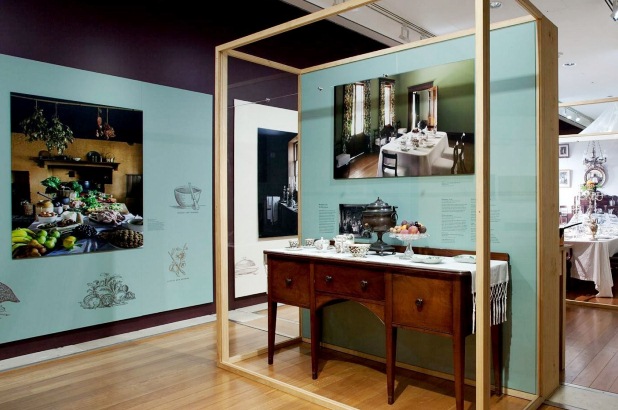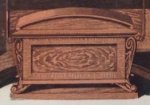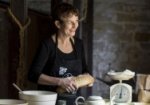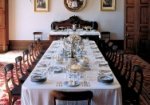Back in December we started looking at dining room furniture, and the ‘esky’ of the 19th century, the wine sarcophagus. Today we’re looking just a foot or two higher, to a piece of furniture many houses have done away with altogether – the sideboard.
Sideboards first appeared in the Renaissance as an arrangement of tiered or stepped ‘shelves’, designed for the display of expensive gold and silver plate. By the Georgian period their use was still partly for display, but primarily as a practical addition to the repertoire of dining furniture. They traditionally sat as the visual focus at the end of the room behind the seated head of the household, often framed by columns or a niche, or set in an apse or other architectural embellishment to set it off nicely. From here wines and glasses and items of food were distributed to guests. In his famous Dictionary (London, 1755) Johnson defined the ‘sideboard’ by its use: “The sidetable on which conveniences are placed for those that eat at the other [i.e. the dining] table”. James Williams (author of my favorite guide to running an early 1800s household) describes the appearance of a tastefully set sideboard:
The sideboard looks tasteful when the glasses are arranged to form a half-circle; in forming which, let the highest glasses be put the furthest off, and the smaller ones in an inner circle; place them two and two, that is, one large and one small, that you may have them handy to put on the table when wanted. In the space between the glasses, place the glass water-jugs, the cruet-stand, the sugar-glass for the dessert, the decanter-stands, with the decanters of wine intended for dessert, and the small handwaiters; place the water-jug, sugar-basin, and cruet stand down on each of them, with the waiters near the edge, in front of the board, as they will be most often wanted; if any space be left, ornament it with a few spoons, as silver sets off glass, and makes the sideboard look well. Let the wine-glasses be to the left-hand, and the ale or beer glasses to the right of the front of the sideboard. [1]
Early Neoclassical sideboards were comparatively delicate affairs compared to their behemoth descendants, and are typified by designs in the second half of the 1700s by Chippendale, Hepplewhite and the Adam brothers. This 1808 design by English designer George Smith is at the late end for this form, but I just love the Egyptian Revival ‘mummiform’ figures as the legs – a reminder of Nelson’s victory at the Battle of the Nile:

‘Design for a sideboard’, from George Smith, Collection of designs for household furniture, J.Taylor, London, 1808. Caroline Simpson Library & Research Collection, Sydney Living Museums RBQ 749.2048.SMI
By adding drawers the familiar ‘Sheraton’ style appeared. This simple yet elegant sideboard with its 6 tapered legs is from the Elizabeth Farm collection. It is provenanced to Belgenny Farm, the ‘home farm’ of Camden Park. Belgenny was home to James and William Macarthur from 1820 to 1834 and this sideboard, created ca.1820 in red cedar, may have been part of its early furnishings. The right hand drawer was for bottles, foreshadowing the next development. A copy is on show at Elizabeth Farm today.

Sideboard from Belgenny Farm, in the Elizabeth Farm Collection. Photo © Sydney Living Museums
…and here it is set with a tea service in the ‘A Shared Table’ exhibition:
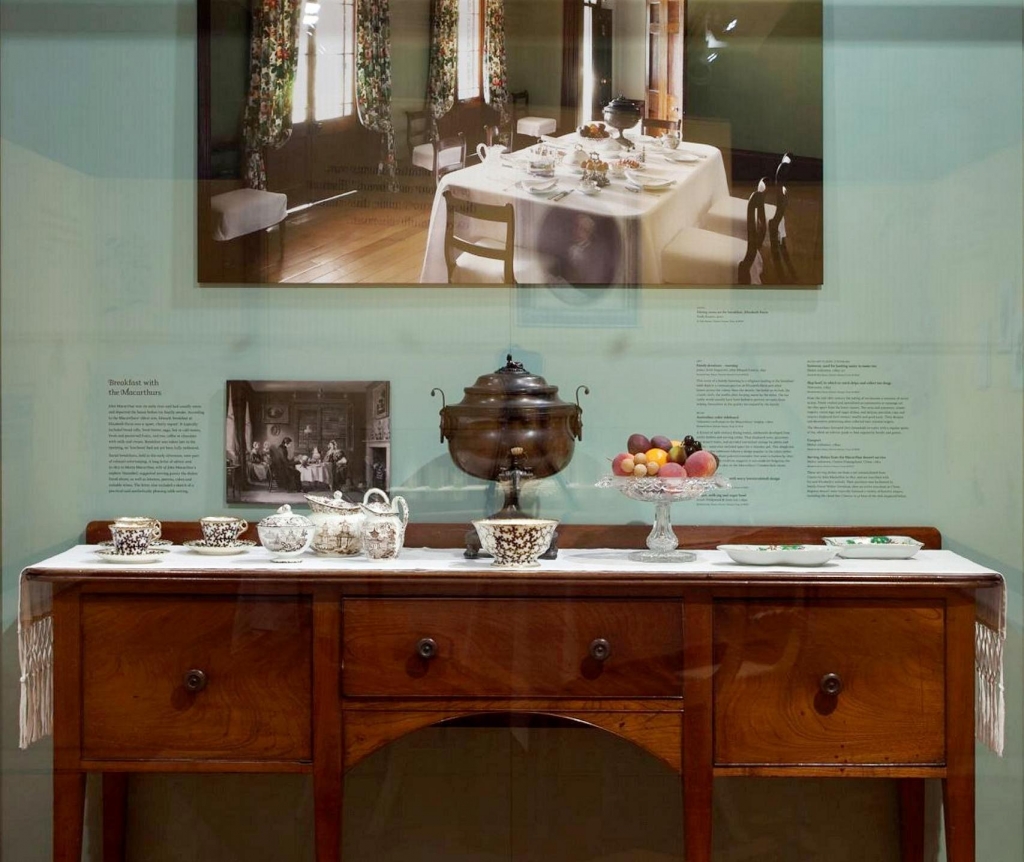
Belgenny sideboard in the Eat Your History: A Shared Table exhibition. Photo © Jamie North for Sydney Living Museums
With its central lunette curve it almost looks like a writing desk. These sideboards – also called ‘sideboard tables’ – could have 6 or 8 legs, and often had an ornamented backboard. They could also have a curved or stepped ‘breakfront’ profile, spiral or turned legs, reeded detailing or any number of embellishments. In grander assemblages they were flanked by pedestals that contained cupboards, plate warmers, bottle storage, a ‘necessary’ (more of that later), and a handy place for your candelabra on the top:
![Sideboard cellaret and flanking pedestals 'Sideboard cellaret and [flanking] pedestals'](../../app/uploads/sites/2/2014/11/618x476xSideboard-cellaret-and-pedestals_Smith_Cabinet-makers-guide-1024x790.jpg.pagespeed.ic.uRFvqBf2PT.jpg)
‘Sideboard cellaret and [flanking] pedestals’, Plate IV from ‘George Smith’s Cabinet makers and upholsterers guide. Caroline Simpson Library & Research Collection, Sydney Living Museums RB749.2048 SMI
And a riddle…
As for the aforementioned ‘necessary’… This illustration – albeit by a French prisoner-of-war satirizing the English – actually depicts a chamber pot in use by a drunken diner, next to an open round pedestal cupboard:
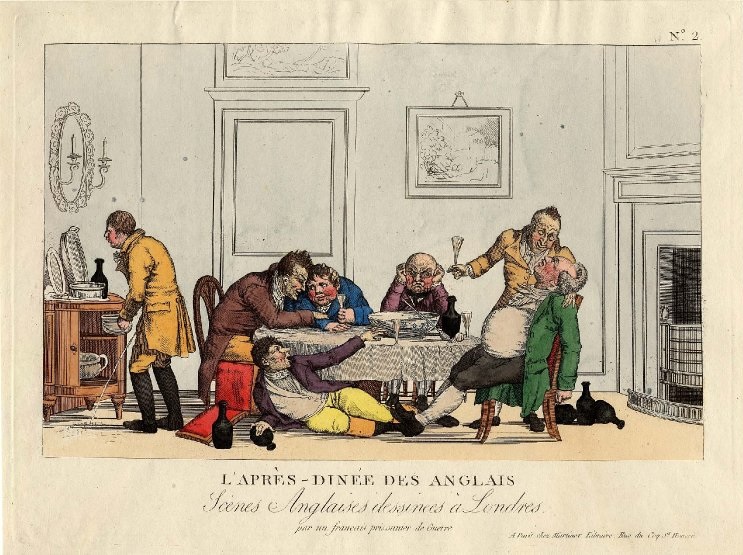
‘Scènes Anglaises dessinées à Londres, par un français prisonnier de guerre / L’après-dinée des Anglais’. France, 1814. (c) The Trustees of the British Museum, 1866,0407.944
If you look at Smith’s 1806 design for the sideboard flanked by cylindrical pedestals, you can read the labels. On the right its a ‘plate warmer’: so far all very obvious and practical. But on the left side and labelled in French is the “Garde de mule de chambre”. Using an 18th-century French dictionary (the Petiti Dictionnaire Francois et Latin, A. Lyon, 1766) this translates as ‘the wardrobe/cupboard for a bedroom slipper’. To me this smacks of a euphemism, especially being written in French, and I suspect it really means ‘chamber pot’. Possibly it derives from the ‘bourdaloue‘, a French bidet used by women that is vaguely slipper-shaped. Does anyone have any linguistic insights?
And when you push the sideboard and pedestals together….
You get the imaginatively titled ‘pedestal sideboard’.
Combining display and storage the very convenient ‘pedestal sideboard’ reigned supreme from the very early 1800s until the 3rd quarter of the 19th century. Though made in every style from the Grecian to the Egyptian and Gothic Revivals, it followed a basic 3-piece construction: two pedestals containing cupboards to the sides and a flat top often incorporating an elaborate backboard that spans between them, and a space between the pedestals for your esky – I mean sarcophagus. The right hand pedestal now typically held a cellaret – in the form of a pull-out drawer for holding wine bottles and, yes, the left hand pedestal could at times contain a ‘necessary’, though this was rapidly disapperaing. Drawers often contained cutlery in purpose-designed, green baize-lined compartments. These designs, for two pedestal sideboards and a sideboard table, were published by Loudon in 1833. The top two are in the Gothic and Greek Revival styles respectively:
Sideboard designs from Loudon’s Encyclopaedia of Cottage, farm and villa architecture, 1833. Caroline Simpson Library & Research Collection, Sydney Living Museums
The bottom drawing could also be used as a serving table, in conjunction with a pedestal sideboard. The serving tables designed by John Verge for Vineyard are quite similar. These examples are from our own collections at Sydney Living Museums; the first is a Rococo Revival sideboard at Elizabeth Bay House. With its serpentine back and front it interprets a Rococo revival addition to his father Alexander’s otherwise sober Grecian villa, made by William Sharp Macleay:
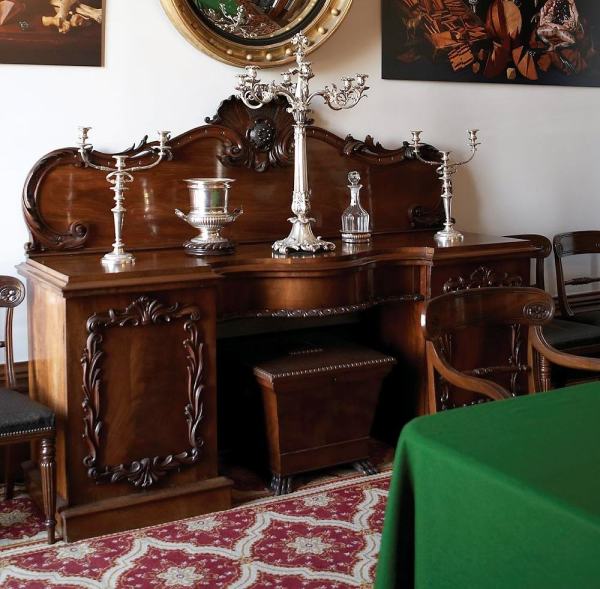
Sideboard at Elizabeth Bay House with a sarcophagus between its pedestal sides. Courtesy Country Threads Magazine © Express Publications Pty Limited
The second, set for use with provenanced wine coolers and glasses, is a rather fanciful Gothic Revival sideboard, ca.1845, at Vaucluse House and once used by the Wentworth family. This sideboard is of oak, and was made by the English furniture makers Druce & Co. It sits framed by a niche, not at one end of the room but to one side. This architectural oddness was due to the room being created as older rooms were combined and refitted. A later, more grandly-planned dining room never eventuated. Though it is embellished with tall, medieval-inspired spires, fleur de lys and quatrefoils, you can clearly see the basic twin pedestal arrangement:
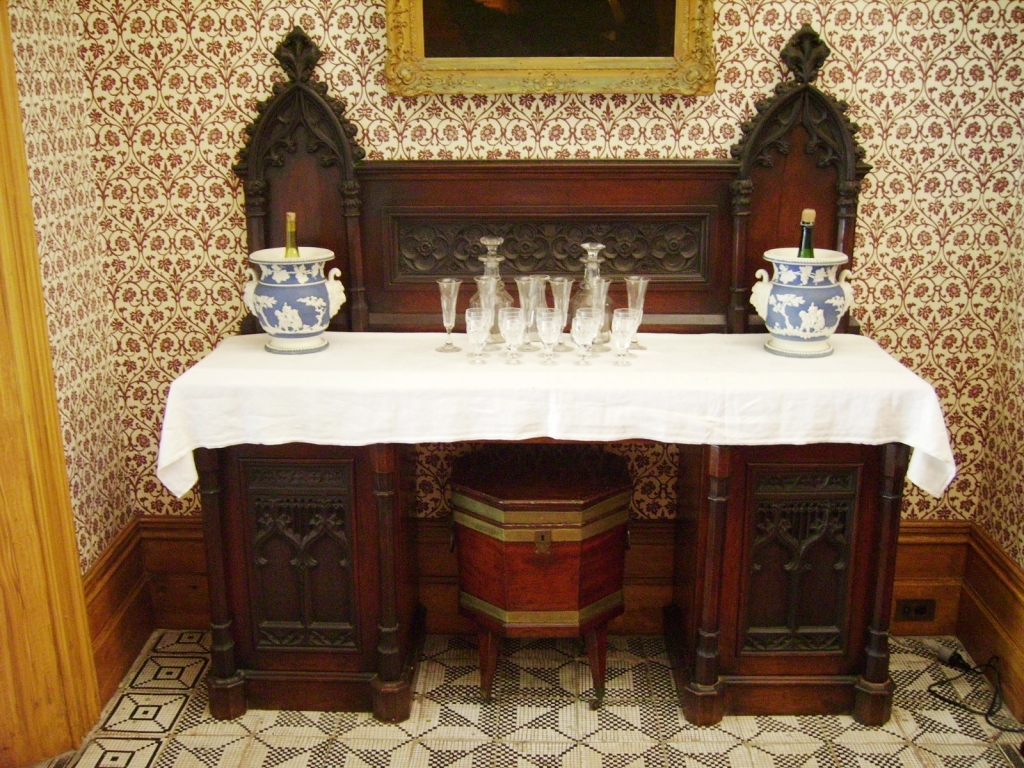
Gothic Revival sideboard at Vaucluse House, Druce & Co., c1845. Photo © Sydney Living Museums
Of course you needed a fairly large room to handle a sideboard. In my next post we’ll look at sideboards and chiffoniers in smaller houses and, in contrast, how the sideboard grew to gigantic proportions later in the century.
Second helpings
If you enter ‘Chatsworth House’ and ‘sideboard’ in your search engine you’ll find a truly gob-smacking recreation of a 1600s sideboard, covered in gilt plate and festoons.
[1] James Williams The footman’s guide, London, Dean and Mundy, 1845 edn.
[2] Richard Twopeny, Town life in Australia. London, Elliott Stock, 1883.
